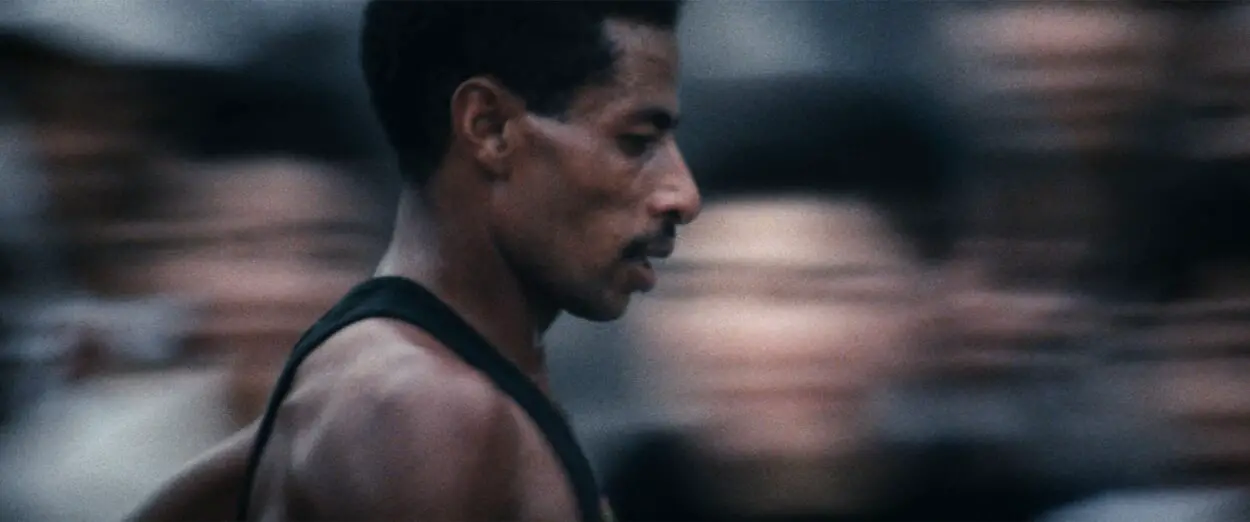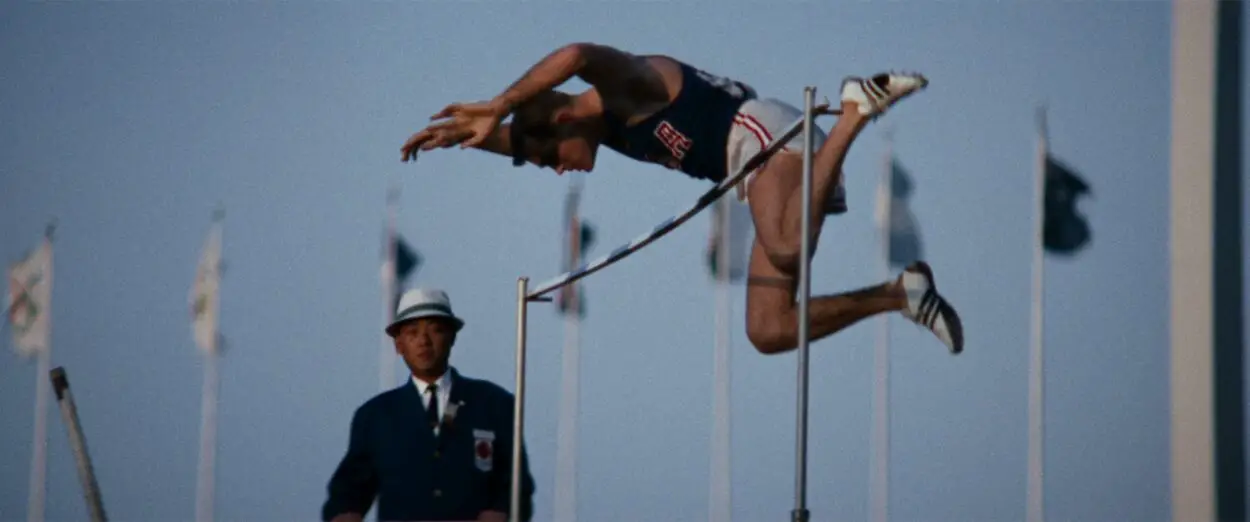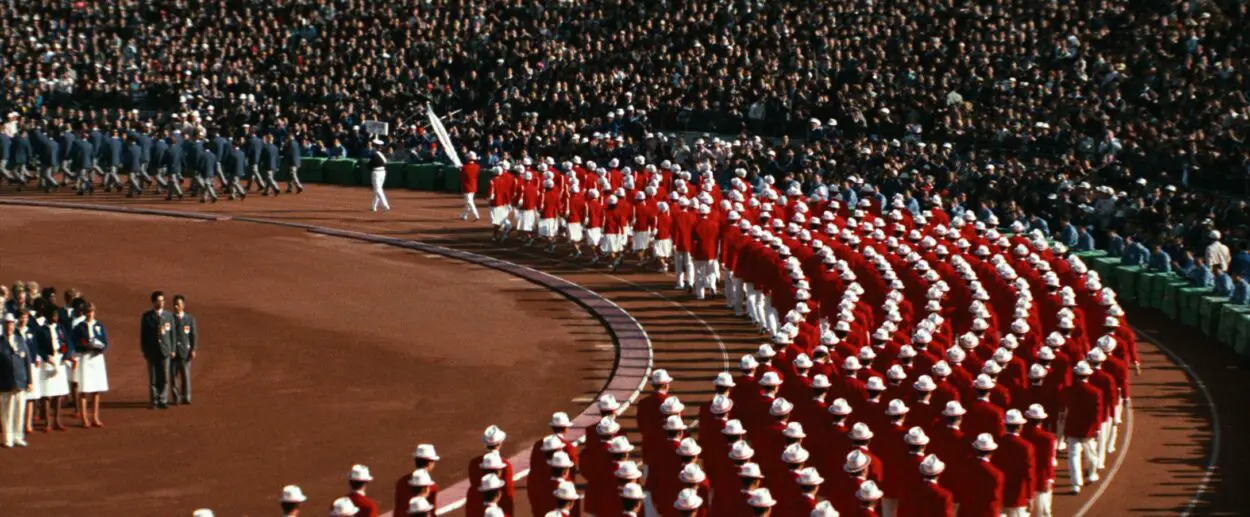In his canonical overview of iconic Criterion Collection documentaries, Will Johnson effusively celebrates the many merits of Tokyo Olympiad, noting, “An entire article could be dedicated to this film alone, as what is an essentially narrative-less story can explain so much about Japan and the world itself in such an effective way. In fact, Tokyo Olympiad isn’t so much about other countries as it is about humanity itself through the guise of competition and personal achievement.” As a co-champion of this timeless masterpiece that doubles as one of the great cinematic heists of all time, I’ve decided to take up this challenge and dedicate an entire write-up to enumerating the many pleasures to be extracted while watching this spectacularly surrealistic ode to physical prowess, formal beauty, and phenomenological filmmaking.
Directed by Kon Ichikawa,Tokyo Olympiad sounds fairly plain on paper: a nationally-funded and produced documentary depicting the 1964 Summer Olympics in Tokyo. On celluloid, however, it is anything but conventional. Instead of recounting the drama of sports competition in a rote manner, it privileges abstract figuration at every turn, crafting a visual meditation on the sublime grace of athletic excellence.
The irony, of course, is that the Japanese government commissioned Kon Ichikawa to make something traditionally inspiring and orthodox. They envisioned a rousing work of nationalist agitprop: an all-encompassing, heartwarming summary of the games that tapped into a sense of Japanese pride and competitive fervor. From the get-go, the governmental body overseeing and funding the project expected a SportsCenter-style tallying of winners and losers, major events, and the opening and closing ceremonies. Sure, these aspects are present, but they are peripheral throughout: constantly enshrouded by Ichikawa’s avant-garde approach, which is more textural than teleological, more poetic than political, and more aesthetically-concerned than athletically-inclined.
As James Quandt brilliantly notes in his Criterion Collection essay “Tokyo Olympiad: The Wind Passing Through the Flagpoles,” a lot was riding on the project. In the wake of World War II, Japan was rebuilding its country and its international image, seeking to campaign itself as a progressive nation that upheld the values of democratic capitalism and pacificism. The Olympics offered the perfect platform for this PR transformation, allowing the country to boost its infrastructure and postwar reputation. With the momentous construction of the Olympic venues, Tokyo underwent a drastic topographical and historical transformation, modernizing almost overnight.
The Japanese government and the Ministry of Education instantly repudiated the initial final edit – a 170-minute tour-de-force of stunning cinematography and impressionistic editing/curation, now available on Criterion. They demanded the documentary be re-edited and condensed –stripped of its artistry and tailored to something more propagandistic, mainstream, orthodox, and sentimental. Ichikawa capitulated, producing a 93-minute version for public broadcast, which became a mega hit – first earning ¥7.5 million in box office admissions before touring the nation with screenings at schools, halls, and public venues (where it reached millions more). To realize the magnitude of its box office success, Tokyo Olympiad would remain the highest-grossing Japanese film in admissions until 2001, when Hayao Miyazaki’s anime classic, Spirited Away, finally ousted it.

Nevertheless, the Japanese Olympic Organizing Committee sponsoring the film complained that the product lacked the sense of grandiosity they wanted to exhibit in the descriptions of the Olympic facilities, such as those for yachting, canoeing, and rowing.” Instead of the macro, Ichikawa focused primarily on the micro, leaving his funders rueful that Kurosawa had arrogantly dismissed the project after his request for twice the budget and total control over the film and the opening and closing ceremonies. Kurosawa would have likely been a more fitting auteur for the documentary, given his knack for scale and scope and ability to craft epic action films like Seven Samurai and tap into timeless poignancy, as seen in something like Ikiru.
At the same time, Ichikawa was not ill-suited for the film. A populist auteur with tremendous versatility, Ichikawa could tight-rope a thin line between mainstream genre entertainment (A Girl at Dojo Temple), biting satire (A Billionaire), and rousing war films (Fires on the Plain). With stunning formality and striking tonal control, Ichikawa was a filmmaker with the creative breadth and technical virtuosity to tackle any project. Unfortunately for those wishing to receive a conventional documentary, he used his expansive toolkit to forge a more timeless than topical (and more artistic than geopolitical) film, showcasing compositional eloquence instead of the thrill and spectacle of Olympic valor and competition.
Prioritizing the quotidian, Ichikawa whittles monumental acts of athleticism down into discrete metonymic units of action. Instead of witnessing a shotput thrown, we look at the chin and forearm repeatedly moving in visceral, physiological permutation. Instead of watching a shooting contest, we meditate on flesh as it folds over the rifle. Instead of observing audiences in the throes of celebration and awe, we see them in awkward, liminal moments and acknowledge their banality, unathletic corpulence, and physiological diversity.
Ichikawa crafts a more clinically removed and simultaneously more poetic depiction of the Olympics by stripping down the spectacle to get to the level of joints, muscles, tissues, ligaments, grit, determination, and resiliency. At times, the surrealistic images reveal eternal truths about the distinctive peculiarity of sport and spectatorship. At times, the idiosyncratic motifs, such as a Sans Soleil-esque montage of parasols and umbrellas, tell a story of fashion, time, zeitgeist, weather, collectivist fashion, and historical setting; at times, the intimate close-ups get at something marrow-deep about the will and weight and forcefulness of the human spirit; at times, the neutral images inadvertently accomplish the conventional task of showcasing an astoundingly raw portraiture of talent – capturing the guts in a grimace, the sheer competitiveness in a superstitious gesture, the perseverance in a bead of sweat.
There’s a pulsating primitiveness to the physicality of Ichikawa’s editing, and this rhythmic quality reveals an underlying ontological depth lurking within the coordination of muscles and sinews. As renegade and overly artsy as his filmmaking choices may have been deemed, Tokyo Olympiad seems to unpack the existential essence of athleticism that the iconic Greek philosophers were perennially preoccupied with articulating and promoting.
For the Greeks, sports were more than a spectacle of national pride or commerce or professional merit; they were a natural extension of our very limbs, intelligence, and synergetic being; they were a conduit for the body to perform and actualize itself in motion, in unity, and perfect form; an artistic vessel upon which the body could mold and shape itself into excellence.

One of the more fascinating aspects of the Olympics is how rudimentary and simplified many events can be. Unlike popularized team sports that revolve around complex rules (offsides, false starts, pass interferences, etc.), oddly inverted norms (intentional fouls, kneeling out a game in victory formation, bunting, etc.), and elaborate technologies (blades, sticks, VAR decisions, scoreboards, etc.), many Olympic sports get back to the basics – running, throwing, jumping, and so forth.
Thus, by honing and zooming in on the repetitive theatrics of athletic performance in Olympian settings, Ichikawa’s quirky fidelity to the body over the sport returns the action to the space of the highly intuitive and loosely conceptual domain. In a way, his camera deconstructs and reassembles the action. One begins to imagine the athlete’s microcosmic obsessions in practices–to meditate upon the synthesis and nuances of various actions, and to intuit how organically certain types of competition morphed from the realm of the theoretical or the obfuscated into the plane of the confined, sportive reality.
At some point, one had to choreograph and design these games – realizing a stick can vault a body, an arm can throw a disc, and that running in circles against other human beings can be invigorating and life-affirming. The invention of sport is also technological: A feat in manipulating objects, tools, and instruments. From shotput to archery, the natural world had to be re-envisioned. Wood, feathers, and string had to become a bow and arrow. Using a synecdochic lens, Ichikawa showcases the totality of sport as it manifests through its individual parts. What becomes of this is a scientifically poetic decoding of each sport’s choreographed patterns: a primordial vision of athleticism in all its magnificence and lyricism.
In a monumental effort to isolate, diversify, multiply, and recontextualize the flow of sportive movement and the visual art of athleticism, Ichikawa had to incorporate a bountiful cinematic vocabulary and acumen. The post-production task must have been exhausting editing down seventy-plus hours of recorded footage (captured by a team of 8 camera operators, 164 assistants, and hundreds of technicians) with his editor, Yoshio Ehara. Maximizing the power of montage and juxtapose, the two worked tirelessly to weaponize an “arsenal of visual effects,” which includes: “freeze-frames, smash cuts, […], image masking, temporal intercutting, rack focus, fragmented and disorienting close-ups […], sudden transitions from color to black […], shadow shots, disruptive zooms, slow motion, and associational edits.”
Relying on spastic zooms, surrealistically intimate shots, still photography (complemented by non-diegetic sound effects), and an artsy 2.35 aspect ratio, the documentary is a never-ending display of technical ingenuity and clever curation. Not only did Ichikawa and Ehara have a ton of footage to pare down, but they also had a vast array of conflicting visual syntaxes, having shot with imported telephoto lenses, noisy high-speed cameras, and 250 kinds of lenses mounted on tailored dollies, mounts, tripods, and other stabilizing equipment. The resulting motley of styles, framings, and formalistic flourishes becomes a tour de force of reactive aesthetics – transforming a non-fiction document into an avant-garde work of renegade voyeurism.

There is both a droll objectivity and a ludic subjectivity intermingling from shot to shot, scene to scene. Boxy ratios give way to spacious widescreen framing; CinemaScope-style, anamorphic lenses were deployed to capture and catalog the expansive scope of the stadiums – conveying the horizontality of the spectacle, populated by Japanese spectators filling the stands. A stark and astute sense of geometry is ever-present – delineated in the striking orthogonal contrasts, the perpendicular cross-cutting, the sloping compositions, the patterned match cuts, the oblique angles, and the transverse tableaux. From one shot to the next, mannered constellations of shapes appear onscreen as they might in a tautly decorated and meticulously constructed Wes Anderson mise-en-scene.
All these flourishes and contrivances highlight the poetry of quotidian happenings in a way that recalls a quote Chris Marker’s narration iterates in Sans Soleil while waxing poetic about the sentimental lyricism and minutely attuned poignancy of the aristocratic class during the era of the 11th century Heian dynasty:
“Do we ever know where history is really made? Rulers ruled and used complicated strategies to fight one another. Real power was in the hands of a family of hereditary regents; the emperor’s court had become nothing more than a place of intrigues and intellectual games. by learning to draw a sort of melancholy comfort from the contemplation of the tiniest things this small group of idlers left a mark on Japanese sensibility much deeper than the mediocre thundering of the politicians. Shonagon had a passion for lists: the list of ‘elegant things,’ ‘distressing things,’ or even of ‘things not worth doing.’ One day she got the idea of drawing up a list of ‘things that quicken the heart.’ Not a bad criterion, I realize, when I’m filming. I bow to the economic miracle, but what I want to show you are the neighborhood celebrations.”
Following this sensibility, Ichikawa seemingly constructs Tokyo Olympiad as a flip book of poetic musings. We witness blood red sunrises, the demolition of stadiums to build new ones, the Olympic torch running from city to city (past villages with charcoaled walls and slate roofing and Mount Fuji in the background), somber faces preparing for the gunshot to kickstart a race, silver-toothed Japanese peasants, traditional red-faced dolls with devilish smiles, press workers’ cigarettes and typewriters, Japanese kids in yellow hats, weird retro binoculars, senescent old men with double chins, a marathon runner hauled off on a stretcher, oral close-ups of athletes eating food in a cafeteria, kimonos and bowler hats, aerial shots of bikers snaking through the woods, etc.

In essence, Ichikawa is clearly concerned with the ephemera that lifts the spirit, but he’s not solely interested in the frivolity of sensory impressions. As intrigued by the peripheral as his vision is, Tokyo Olympiad also basks in the rules of sporting events and the psychology of athletes, profoundly accentuating eternal human qualities: focus, determination, perseverance, endurance, flexibility, and grace. For every goofy and grotesque vignette, there is a dramatic segment capturing the pomp and pageantry of competition, chronicling grimaces and sweat, and bathing the picture in the pathos of stinging defeat. For every off-kilter montage of quotidian tidbits, he includes a detailed recap of a volleyball match or a baton race.
For example, we witness a vaulting event that extends well into the wee hours of the night as vaulters dig deep and become meditative in their mid-jump preparations. We watch freeze-frame shots of the runners to get a sense of their limbs in stop-motion. We observe a long jump in slow motion. World records are broken. Jaunty, cartoonish tunes accompany some events. Others take on a more epical heft. Equal parts dramatic and comedic in Tokyo Olympiad, we survey faces as they jump over hurdles and jiggle in tune. A jazz ditty carries a bicycling event. A spritely song elevates a gymnastics competition into a balletic whimsy, conjuring up connotations of The Nutcracker. Oboe strings crescendo into squeaky bars as a sideways shot of a flying bars routine wows the gaze.
There’s a richness to the diversity of ethnicities, nationalities, costumes, and body physiques on display. Backstories seep into the picture, and we learn that many athletes double as police officers, schoolteachers, and mothers. After a female teacher wins, we watch her embrace two dudes. A runner sporting a Nippon tracksuit dawdles and paces, whistling, somersaulting backward, handling his nerves poorly. The film’s intermission prudently comes after Japan wins volleyball gold on a net foul. We get to know one of the two athletes from Chad, Ahmed Issa, learning his father died of smallpox, he runs barefoot, he speaks one of a hundred dialects, he comes in second to last, he appears lonely, and he returns home right after the closing ceremony with no time to sightseeing.
Ichikawa even takes the time to break down a few events, such as weightlifting, which consists of three primary moves, including “the jerk.” He manages to capture beam sequences in hyper-speed. He shoots boxing matches in black-and-white, paying close attention to the boxing coach reacting. He fixates on a pair of fencers’ feet as they spar. He uses a freeze-frame to get a still snapshot of a flip in a judo match. At times, the pacing is slapdash and jagged. At other times, it felt fluidly reminiscent of Phantom India, ecstatically building into a full orchestra of jubilation. Some snippets are tactile – a rushing stream, a blast of wind rattling flagpoles, a nauseating sailing sequence, a silent hurdling event broken when a barrier is hit; some are semiotic – women in kimonos deliver medals on a tray, a furiously plodding “walking race” is laughable to look at, a camera squaring in on the metal grates that runners place their backfoot upon is both poetic and filled with suspense; everything is seismic – capturing the spectacle of life.


